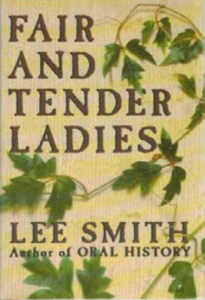Since I introduced Lee Smith in my earlier series on Virginia writers, I will concentrate in this column on Smith’s use of Southwest Virginia as the setting and subject matter for her novel, Fair and Tender Ladies (1988). Smith grew up hearing many local stories from her maternal grandmother, a native of the Grundy, Virginia area where Lee Smith was born and grew up. A precocious reader and writer, Smith has said, “Fiction has always been how I try to make sense of my own life. I am not my characters, but often they are going through things I’ve been through.” Beginning with The Last Day the Dogbushes Bloomed (1968), her novels validate that comment.

Lee Smith)
After Smith married the poet James Seay, they moved around the South to his various teaching assignments. During her years as the young mother of two sons, Smith continued to write novels; Something in the Wind (1971) and Fancy Strut (1973) feature young women trying to find satisfactory lives in the modern world. When her first marriage ended in divorce, Smith wrote her darkest novel on that subject, Black Mountain Breakdown (1981).
Settling permanently in North Carolina and marrying journalist Hal Crowther–this marriage has endured–led Smith to find her central subject: Appalachian life and culture. Fair and Tender Ladies is, arguably, her most important novel set in her native area. Smith has said, “This is the book of my heart. It is a love story to southwest Virginia. It memorializes and documents an earlier way of life.” She wrote it, she says “for the older Appalachian women, I was privileged to know as I was growing up.”
Fair and Tender Ladies introduces one of the strongest women created in the fiction of the late 20th-century. Smith wrote the novel at a difficult time in her own life: her mother was dying and her son Josh had just been diagnosed with schizophrenia. Smith says, “Ivy Rowe grew stronger and stronger, the more I needed her.”
Smith tells Ivy’s story using the epistolary technique–letters. Ivy writes actual letters to her older sisters, former teachers, and others, but her richest letters are the unsent ones she writes to her mentally-challenged sister, Silvaney, who, after suffering a manic episode, has been taken to a mental hospital in Roanoke. Silvaney dies early, but Ivy continues to write letters to her. Before writing Fair and Tender Ladies, Smith had actually found a packet of letters (between sisters) at a flea market in Greenville, South Carolina, but Ivy’s letters tell her story and develop her character. Smith has said, “[I] was trying to show that [for Ivy] the writing of the letters was more important than the letters.” Like her creator, Ivy Rowe is s a natural story teller with a strong creative imagination and a desire to leave an enduring legacy.
Ivy Rowe begins as a highly intelligent and imaginative child who, through no fault of her own, suffers in poverty-stricken circumstances in Sugar Fork, Virginia. Her mother, from the middle class, has married for love, but after about fifteen years her husband dies of heart disease, leaving her with eight children. Ivy, influenced by a teacher who runs the local school, dreams of becoming a teacher herself. She enters high school, but her dream ends after an alarming encounter with another teacher. Then Ivy, involved in a passionate affair, becomes pregnant but chooses not to marry the child’s father, a young soldier who dies in World War I. For seven years, Ivy and her daughter, Joli, live in a coal mining camp with her an older sister and her family. There, Ivy becomes involved with the son of the mine manager and experiences another uncertain period of physical passion.
Ultimately, after an explosion at the mine, she marries Oakley Fox, a miner who has been a childhood friend. They return to her family farm at Sugar Fork where Ivy has four more living children; she becomes depressed after hard work and only limited success. She enters another affair that restores her personal balance even though it damages her local reputation. Her long-term marriage with her forgiving husband goes on in spite of the affair; she resumes a meaningful life with her husband and successful children. Still when Oakley dies, Ivy welcomes newfound freedom, achieving success as an environmentalist–she successfully prevents strip-mining on her farm.
 As I mentioned earlier, Smith wrote the book as an epistolary novel, a form originally conceived in the 18th Century Samuel Richardson; Smith makes the form work as the letters show Ivy’s developing sensibility. She begins as a naive, but passionate child with only limited understanding of the world around her; through time she develops in vocabulary and stylistic maturity as she passes through self-education and the difficulties of existence. Other strengths of the novel include Smith’s ability to create numerous, well-developed minor characters. Two, who introduce folklore into the novel, are elderly Rowe great-aunts who tell native stories, offer superstitions, and apply folk remedies. Smith’s ability to create the rural landscape of Southwest Virginia is also strong; Ivy especially appreciates the power of Blue Star Mountain that rises above her home; despite its seriousness, however, the novel does not lack humor. Once her husband has died, for example, Ivy relishes eating a hot dog for breakfast!
As I mentioned earlier, Smith wrote the book as an epistolary novel, a form originally conceived in the 18th Century Samuel Richardson; Smith makes the form work as the letters show Ivy’s developing sensibility. She begins as a naive, but passionate child with only limited understanding of the world around her; through time she develops in vocabulary and stylistic maturity as she passes through self-education and the difficulties of existence. Other strengths of the novel include Smith’s ability to create numerous, well-developed minor characters. Two, who introduce folklore into the novel, are elderly Rowe great-aunts who tell native stories, offer superstitions, and apply folk remedies. Smith’s ability to create the rural landscape of Southwest Virginia is also strong; Ivy especially appreciates the power of Blue Star Mountain that rises above her home; despite its seriousness, however, the novel does not lack humor. Once her husband has died, for example, Ivy relishes eating a hot dog for breakfast!
The novel received strong critical praise including that of fellow-novelist Clyde Edgerton: “Fair and Tender Ladies is far, far beyond marvelous. Nothing I can say will do it justice.” Edgerton’s praise is clearly on target.































